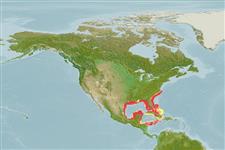Common names from other countries
Classification / Names / Names
Common names | Synonyms | Catalog of Fishes (gen., sp.) | ITIS | CoL | WoRMS
Environment: milieu / climate zone / depth range / distribution range
Ecology
Benthic; depth range 0 - 183 m (Ref. 83435). Tropical; 37°N - 14°N, 100°W - 65°W (Ref. 83435)
Western Central Atlantic: from North Carolina to Texas, Mexico, Belize, and Puerto Rico.
Length at first maturity / Size / Weight / Age
Maturity: Lm ?, range 7 - 10 cm Max length : 11.2 cm DL male/unsexed; (Ref. 83435)
The 144.9 mm size reported by Wagner & Abbott (1973) needs confirmation. Wagner & Abbott (1967) reported a maximum size of 117 mm, which itself is an error for 112 mm (specimen is in ANSP; Ref. 83435). Inhabits seagrass beds, shallow reefs, sand and rubble (Ref. 106835). Feeds on diatoms and other epiphytic algae. Resides in deep waters of 10 m or greater during winter and migrates to shallow waters of 2 m during summer to spawn (Ref. 105282).
Broadcast spawners. Life cycle: Free-swimming larvae hatch from eggs and develop into veligers which later settle down the water column and undergo metamorphosis into juvenile conch (Refs. 833, 105282). Mating behavior: Males that attempt to mate with a female being guarded by another male fight over with each other in a sparring contest using their proboscis (Refs. 105242, 105282).
Bisby, F.A., M.A. Ruggiero, K.L. Wilson, M. Cachuela-Palacio, S.W. Kimani, Y.R. Roskov, A. Soulier-Perkins and J. van Hertum. 2005. (Ref. 19)
IUCN Red List Status (Ref. 130435)
CITES status (Ref. 108899)
Not Evaluated
Not Evaluated
Human uses
Fisheries: commercial; aquaculture: commercial
| FishSource |
Tools
More information
Age/SizeGrowthLength-weightLength-lengthMorphologyLarvaeAbundance
Internet sources
Estimates based on models
Preferred temperature
(Ref.
115969): 21.7 - 27.7, mean 24.9 (based on 268 cells).
